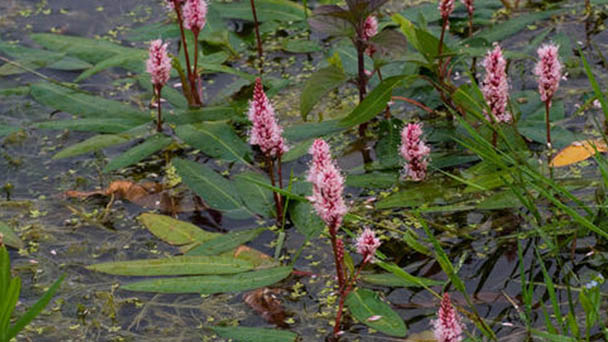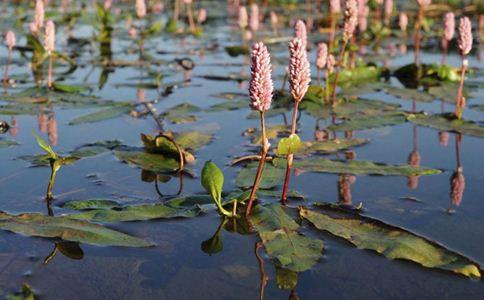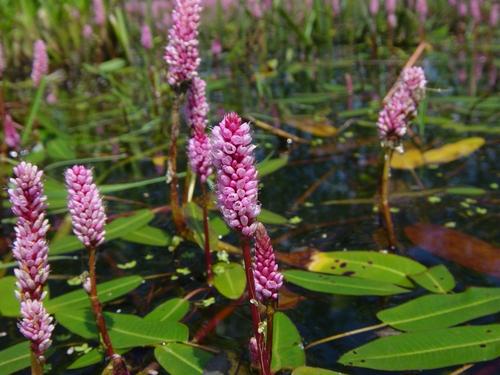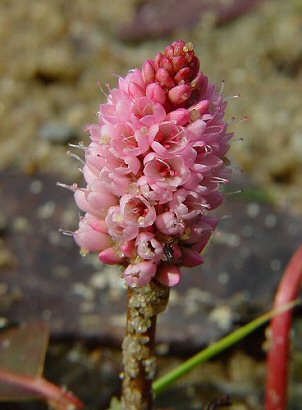Water knotweed (Persicaria amphibia) profile
Written by Maggie
Mar 04 2021

Water knotweed (Latin name: Polygonum amphibium L.) is a perennial herb of the genus Polygonum in the Polygonaceae family, having transverse rhizomes. Racemes are spicate, terminal or axillary. Achene is suborbicular, biconvex, black, lustrous, enclosed in persistent perianth. Water knotweed is widely distributed in Asia, Europe and North America.
Water knotweed is born in shallow Water at the edge of lakes, ditches and wetlands near fields, with an altitude of 50-3700 meters. water knotweed can be used for dysentery and whitlow boils.In addition, Water knotweed has large leaves, large flower spikes and attractive pink inflorescence, which makes it a good ornamental plant in the Water landscape.
Water knotweed picture

Morphological characteristics of water knotweed
Rhizome
Herbs of perennial Water knotweed, rhizomes transverse. In water: Stems are floating, glabrous, nodal adventitious roots.
Leaf
Leaves of Water knotweed are oblong or elliptic, floating on Water, 5 -- 12 cm long, 2.5 -- 4 cm wide, tip obtuse or slightly acute, base subcordatate, both surfaces glabrous, entire, glabrous; Petiole is 0.5-3 cm long, emanating from near middle of opiculus sheath; Stipules of Water knotweed are cylindric, membranous, 1-1.5 cm long, apex truncate, glabrous; Terland born: Stems are erect, unbranched or branched from base, 40-60 cm tall, leaves lanceolate or oblong-lanceolate, 6-14 cm long and 1.5-2 cm wide, apical acute, base subrounded, both surfaces short hirsute, entire, ciliate; Petiole is 3-5 mm, emanating from middle opiculus sheath; Stipules of Water knotweed are cylindric, membranous, 1.5-2 cm long. Sparsely growing hirsute, apex truncate, with short ciliate.
Flowers
Water knotweed racemes spicate, terminal or axillary, 2 -- 4 cm long, bracts broadly funnel-shaped; Perianth is 5-lobed, reddish or white, oblong, 3-4 mm long;Stamens usually 5, shorter than perianth; Style 2, longer than perianth, stigma capitate.
Fruit
Achenes of Water knotweed are suborbicular, biconvex, 2.5 -- 3 mm in diam., black, glossy, enclosed in persistent perianth.
The flowering period of Water knotweed is in summer, and the fruiting period is in autumn.
Ecological habits of water knotweed
Water knotweed grows in shallow Water, ditches and field wetlands at the edge of lakes, 50-3700 meters above sea level.

How to control water knotweed
Combination of agronomic measures and chemical weeding should be adopted for control.
(1) The main agronomic measures are as follows: firstly, the rice production environment should be established with smooth land, smooth ditch, good water retention and free irrigation; Two is the combination of seed treatment to remove weed seeds, and combined with ploughing, land preparation, eliminate weed seeds on the soil surface; The third is to implement regular crop rotation, reduce the occurrence of weeds;Four is to improve the quality of sowing, sowing seedlings, seedlings to press grass.
(2) Chemical weeding, most places use one-time closure, is in 1-3 days after sowing (accelerating germination), with 40% "direct green" wettable powder 60 grams, mixed with water 40-50 kilograms, uniform spray, pesticide application field plate to keep wet.Irrigation and field management were resumed after 3 days.After removal, if there is still a certain amount of weeds in the later stage, targeted method can be adopted for supplementary removal.
The distribution area of water knotweed
Water knotweed is produced in Northeast, North, Northwest, East, Central and Southwest China.
Water knotweed is distributed in Asia, Europe and North America.
Water Knotweed garden use
Water knotweed is an ornamental plant with large leaves, large flower spikes and lovely pink inflorescence.
Water knotweed flower language
Water knotweed: usually refers to dependence, aspiration and yearning.

Latest Updated
- Benefits of Bugleweed - 7 Science-backed Health Benefits
- Bugleweed Dangers & Side Effects - Is It Poisonous?
- How to Plant Evergreen Trees - What You Should Know
- When to Plant Evergreens - Grow Guide for Evergreen Trees
- 12 Wonderful Evergreen Shrubs for Your Garden
- 12 Popular Evergreen Plants with Pictures for Beginners
- When And How To Prune A Lilac Bush Like a Pro
- How to Grow & Care for Lilac Vine (Hardenbergia Violacea)
- Japanese Lilac Tree (Syringa Reticulata) Care & Propagation Guide
- Shumard Oak Pros and Cons - What to Know
Popular Articles
- Winter maintenance of Antirrhinum Majus
- How to Grow Terminalia Mantaly Tree
- How to Grow and Care for Crossostephium Chinense
- How to grow Antirrhinum Majus in spring
- Peristeria Elata (Dove Orchid) Profile: Info & Care Guide
- Underwatered Snake Plant (Sansevieria Trifasciata) - Signs And How To Fix
- How to Care for Brazilian Jasmine Plant (Mandevilla Sanderi)
- How to Grow & Care for Graptopetalum Purple Delight in Summer
- Rosa Chinensis (China Rose): Plant Growing & Care Tips
- How to Care for Baby Sun Rose (Aptenia Cordifolia)